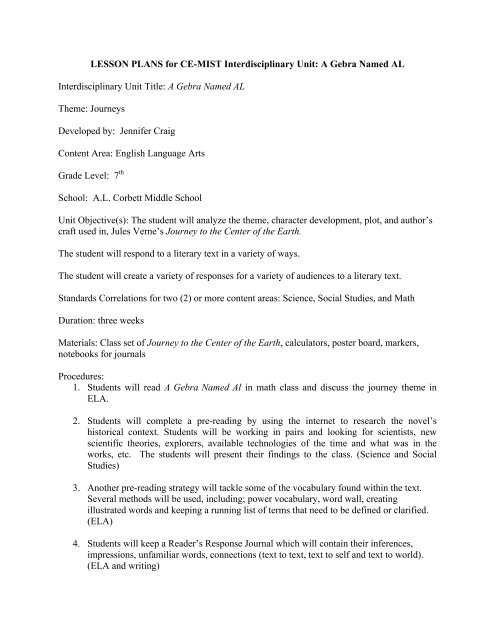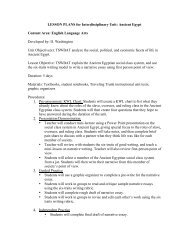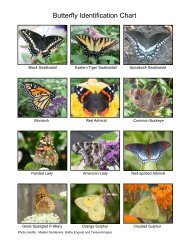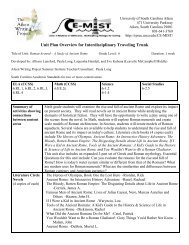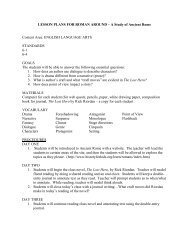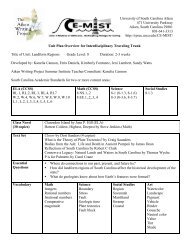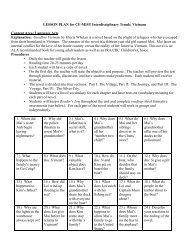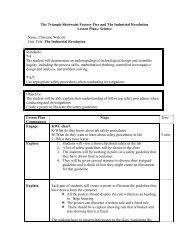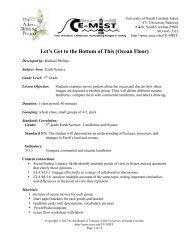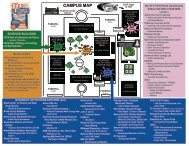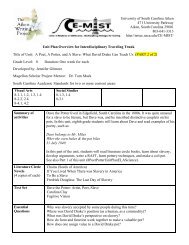A Gebra Named Al Lesson Plans - The Ruth Patrick Science ...
A Gebra Named Al Lesson Plans - The Ruth Patrick Science ...
A Gebra Named Al Lesson Plans - The Ruth Patrick Science ...
Create successful ePaper yourself
Turn your PDF publications into a flip-book with our unique Google optimized e-Paper software.
LESSON PLANS for CE-MIST Interdisciplinary Unit: A <strong>Gebra</strong> <strong>Named</strong> ALInterdisciplinary Unit Title: A <strong>Gebra</strong> <strong>Named</strong> AL<strong>The</strong>me: JourneysDeveloped by: Jennifer CraigContent Area: English Language ArtsGrade Level: 7 thSchool: A.L. Corbett Middle SchoolUnit Objective(s): <strong>The</strong> student will analyze the theme, character development, plot, and author’scraft used in, Jules Verne’s Journey to the Center of the Earth.<strong>The</strong> student will respond to a literary text in a variety of ways.<strong>The</strong> student will create a variety of responses for a variety of audiences to a literary text.Standards Correlations for two (2) or more content areas: <strong>Science</strong>, Social Studies, and MathDuration: three weeksMaterials: Class set of Journey to the Center of the Earth, calculators, poster board, markers,notebooks for journalsProcedures:1. Students will read A <strong>Gebra</strong> <strong>Named</strong> <strong>Al</strong> in math class and discuss the journey theme inELA.2. Students will complete a pre-reading by using the internet to research the novel’shistorical context. Students will be working in pairs and looking for scientists, newscientific theories, explorers, available technologies of the time and what was in theworks, etc. <strong>The</strong> students will present their findings to the class. (<strong>Science</strong> and SocialStudies)3. Another pre-reading strategy will tackle some of the vocabulary found within the text.Several methods will be used, including; power vocabulary, word wall, creatingillustrated words and keeping a running list of terms that need to be defined or clarified.(ELA)4. Students will keep a Reader’s Response Journal which will contain their inferences,impressions, unfamiliar words, connections (text to text, text to self and text to world).(ELA and writing)
LESSON PLANS for A <strong>Gebra</strong> <strong>Named</strong> <strong>Al</strong>, Page 2 of 65. Students will create a travel guide to the center of the Earth in the form of a pamphlet orbrochure using details and events from the novel.6. Students will create diagrams/illustrations of the bisected Earth, including the descent andsubsequent discoveries. Students will use ratios and proportion formulas to assure theillustration is accurate.Assessment: Journey to the Center of the Earth Portfolio, containing pieces completed prior to,during and after the reading.
LESSON PLANS for A <strong>Gebra</strong> <strong>Named</strong> <strong>Al</strong>, Page 3 of 6Interdisciplinary Unit Title: A <strong>Gebra</strong> <strong>Named</strong> ALContent Area: MathematicsDeveloped by: Jeni LambertGrade Level: 7 thSchool: A.L. Corbett Middle SchoolUnit Objective(s): <strong>The</strong> student will demonstrate through the mathematical processes anunderstanding of the representation of rational numbers, percentages, and square roots of perfectsquares; accurate, efficient, and generalizable methods for operations with integers; themultiplication and division of fractions and decimals; and the inverse relationship betweensquaring and finding the square roots of perfect squares. <strong>The</strong> student will demonstrate throughthe mathematical processes an understanding of proportional relationships.Standards Correlations for two (2) or more content areas: Math, <strong>Science</strong>, & ELADuration: two weeksMaterials: A <strong>Gebra</strong> <strong>Named</strong> <strong>Al</strong> (and other supporting books listed on the inventory sheet), Pichart, <strong>Al</strong>gebra postersProcedures:1. Students will read A <strong>Gebra</strong> <strong>Named</strong> <strong>Al</strong> in math class.2. Students will use the Pi chart to guide them as they determine Pi using circumference anddiameter.3. Students will use “<strong>Al</strong>gebra Posters” to race against the clock in a Round Robin “I Have,Who Has” game to help them understand algebra rules, and real-life applications of therules.4. Students will write a math story or poem with algebra topics.Assessment: <strong>Al</strong>gebra quiz
LESSON PLANS for A <strong>Gebra</strong> <strong>Named</strong> <strong>Al</strong>, Page 4 of 6Interdisciplinary Unit Title: A <strong>Gebra</strong> <strong>Named</strong> ALDeveloped by: Erria DanielsContent Area: <strong>Science</strong>Grade Level: 7 thSchool: A.L. Corbett Middle SchoolUnit Objective(s): <strong>The</strong> student will demonstrate an understanding of the classifications andproperties of matter and the changes that matter undergoes & use the periodic table to identifythe basic organization of elements and groups of elements.Standards Correlations for two (2) or more content areas: <strong>Science</strong>, Social Studies, & ELADuration: one weekMaterials: Periodic Table card deck, Elements Challenge game, Periodic Table Toss-Up BallProcedures:1. Students will read A <strong>Gebra</strong> <strong>Named</strong> <strong>Al</strong> in math class.2. Students will use “Periodic Table Card Deck” to form a periodic table as a class that willbe over 7 feet long.3. Students will use “Elements Challenge” to race against the clock in a Round Robin “IHave, Who Has” game to help them understand common elements, their chemicalsymbols, and real-life applications of the elements.4. Students will practice naming element symbols by tossing the ball to each other, givingthe element name for the number and symbol on which their left thumb lands.Assessment: Periodic Table quiz
LESSON PLANS for A <strong>Gebra</strong> <strong>Named</strong> <strong>Al</strong>, Page 5 of 6Interdisciplinary Unit Title: A <strong>Gebra</strong> <strong>Named</strong> <strong>Al</strong>Content Area: Social StudiesDeveloped by: Marianne BerstGrade Level: 7 thSchool: A.L. Corbett Middle SchoolUnit Objective(s): <strong>The</strong> student will demonstrate knowledge of the growth and impact of globaltrade on world civilizations after 1600.Duration: one weekMaterials:STANDARD SUPPORT DOCUMENThttps://www.ed.sc.gov/apps/cso/standards/socsd_k8.cfm?#grade_7Websites:This site is a colored map of the Americas showing the extent of European colonization.http://www.shmoop.com/pictures/index/history/hist00038/1750_european_colonization_of_america01.htmlThis site shows which European powers colonized in each part of the Americas.http://encarta.msn.com/encnet/refpages/RefMedia.aspx?refid=461517442&artrefid=761576293&pn=3&sec=-1www.scdiscus.orgclick on History Resource Center: World HistoryETV StreamlineSCwww.scetv.org/education/StreamLineSCmap of world, map of EuropeProcedures:1. Have the students identify which European powers colonized in each of the differentcolored areas on the map at the website:http://www.shmoop.com/pictures/index/history/hist00038/1750_european_colonization_of_america01.html2. Have the students label a map of Europe on a blank world map or on a dry erase map ifavailable. Have them draw lines from European countries to their respective colonies.<strong>The</strong>n have them interpret the influence of each European country based upon their spreadacross the globe either through discussion or in written form.
LESSON PLANS for A <strong>Gebra</strong> <strong>Named</strong> <strong>Al</strong>, Page 6 of 63. Have the students color code a blank map of the Americas to represent the Europeanpowers that colonized there.4. Have students write a letter back home as if they were an explorer describing theirexperiences.Assessment: Maps, letter


